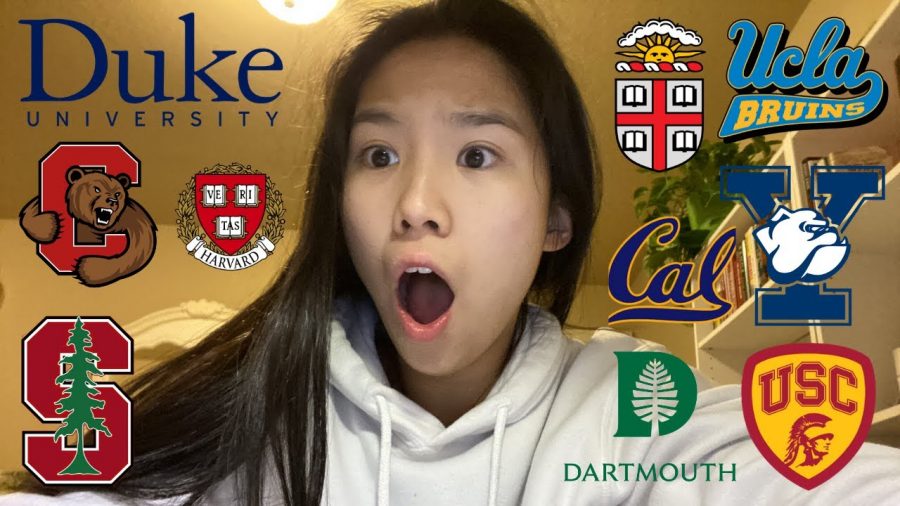My Reactions to College Decision Reaction Videos
YouTuber Iris Fu’s college decision reactions video with over 300k views.
It’s finally the last month of school and that means college decisions for seniors and college decision reactions for paranoid juniors such as myself. These days, it has become popular for high school seniors to record themselves when opening their college decisions and compile all of their recordings into a nicely edited YouTube video titled “COLLEGE DECISION REACTIONS.”
And who, you may ask, would want to sit through a video of some random person opening their college decisions? Only about thousands of underclassmen across the country as many of these videos receive anywhere from 1,000 to 100,000 views over a couple of months.
A typical college decision reaction video usually begins with an overly stressed teenager giving a brief background on their application process. They talk about how many colleges they applied to (usually a large amount) and sometimes provide background information about themselves such as basic demographic information and which major they applied to. Then, the video proceeds with the actual reactions to college decisions, starting with Early Decision and Early Action schools and ending with the Regular Decision schools like Ivy Leagues and Stanford (the schools that are usually last to release decisions).
Personally, I enjoy watching such videos and experiencing the highs and lows of someone’s college application process. I smile when a scrawny 18-year-old gets into his dream school and cry when a short-haired girl gets rejected from 10 schools in a row. It’s like I’m watching one of those suspenseful movies where no one knows what is going to happen next, but everything works out in the end.
Additionally, watching these types of videos has taught me so much about the college admissions process. I’ve learned the difference between Early Decision, Early Action, Regular Decision, and which of these rounds to apply in for specific schools. I’ve learned that creating a balanced college list is an important step to take before doing anything else. Most importantly, I’ve learned that the college admissions process can be very random in that you never know what will happen. I’ve seen perfect applicants with 4.0 GPAs and 1600 SAT scores get rejected from Ivy League schools and more “average” applicants accepted to those same schools. That’s why it’s important to keep an open mind and a positive attitude when applying to colleges.
On the other hand, because these college decision reaction videos are typically posted on YouTube for everyone to see, there has been a lot of controversy surrounding such content. Many reaction videos serve as a jumping point for a college YouTuber’s career as they begin to create more college content in the form of essay videos and day-in-the-life vlogs. Especially for essay videos, there have been several cases of plagiarism where viewers have been caught plagiarizing parts of the essays they see on YouTube. Some viewers are even accepted to schools like Harvard and Stanford with plagiarized essays.
Such videos can also create a false sense of reality when it comes to college admissions. I recently learned about a psychological concept called volunteer bias that states that people who volunteer to participate in a certain activity or study are often a very specific subset of the general population so it doesn’t make sense to apply the data gathered from that activity/study to the entire population of people. In this case, most of the people who volunteer to make college decision reaction videos are part of a specific group of teenagers. They might have received numerous acceptances from top schools and might have wanted to show these acceptances to friends and family or might have been proud enough to post their acceptances on the internet.
Most of the college decision reactions videos you see on YouTube showcase teenagers that receive mostly positive results because people with a large number of rejections and waitlists are less likely to post their reactions. Therefore, the YouTube college admissions environment is not the most accurate place to go to determine your chances of acceptance since the content is slightly biased.
I would still encourage high school students (especially rising juniors and seniors) to check some of these videos out because there is a lot you can learn from them. Just remember not to take them too seriously because everyone has their own unique college experience that is much more than what is captured in a 15 minute YouTube video.
Your donation will support the student journalists of Chamblee High School Blue & Gold. Your contribution will allow us to print editions of our work and cover our annual website hosting costs. Currently, we are working to fund a Halloween satire edition.

Ashika Srivastava is a senior and editor for the Blue & Gold. In five years, she hopes to be recounting the great tale of how she lived through a global pandemic. For her, the movie "Beauty & the Beast" best encapsulates both the beautiful and sometimes scary parts of her Chamblee experience. This is her second year on the staff.





Brian • Aug 20, 2024 at 8:39 pm
First thing I read that does not bash on college decision reaction.